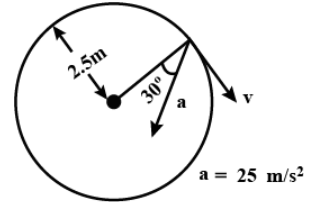
The radial acceleration is

A.
B.
C.
D.

Answer
477.6k+ views
Hint: We have to find radial or centripetal acceleration here.
We need to break the acceleration vector into its two rectangular components.
As we know, centripetal acceleration is always along the centre and radius in a circle.so the horizontal component of the given acceleration vector will be the radial acceleration of the body .Also, radial acceleration is always perpendicular to the velocity vector.
Complete answer:
Centripetal acceleration is responsible for a body’s moment in circular motion.it is the acceleration due to the force which is resultant of all the forces acting on the body.
The radial or centripetal acceleration is perpendicular to the velocity vector.
As the angle between radius vector and net acceleration is given, we will break the given acceleration into its vertical and horizontal components and we will see that the horizontal component is the radial or centripetal acceleration as it is along the centre and radius of the circular path.
It a vector
Horizontal component -
Vertical component-

So according to above information, the components of acceleration will be
Horizontal component -
Vertical component-
Given value,
a=
Radial acceleration:
Hence the radial acceleration has come and the correct option is D.
Note:
The perpendicular component of the acceleration
It is responsible for change in the magnitude of velocity.
Also, it is present only in the case of non-uniform circular motion.
We need to break the acceleration vector into its two rectangular components.
As we know, centripetal acceleration is always along the centre and radius in a circle.so the horizontal component of the given acceleration vector will be the radial acceleration of the body .Also, radial acceleration is always perpendicular to the velocity vector.
Complete answer:
Centripetal acceleration is responsible for a body’s moment in circular motion.it is the acceleration due to the force which is resultant of all the forces acting on the body.
The radial or centripetal acceleration is perpendicular to the velocity vector.
As the angle between radius vector and net acceleration is given, we will break the given acceleration into its vertical and horizontal components and we will see that the horizontal component is the radial or centripetal acceleration as it is along the centre and radius of the circular path.
It a vector
Horizontal component -
Vertical component-

So according to above information, the components of acceleration will be
Horizontal component -
Vertical component-
Given value,
a=
Radial acceleration:
Hence the radial acceleration has come and the correct option is D.
Note:
The perpendicular component of the acceleration
It is responsible for change in the magnitude of velocity.
Also, it is present only in the case of non-uniform circular motion.
Latest Vedantu courses for you
Grade 10 | MAHARASHTRABOARD | SCHOOL | English
Vedantu 10 Maharashtra Pro Lite (2025-26)
School Full course for MAHARASHTRABOARD students
₹31,500 per year
Recently Updated Pages
Master Class 11 Economics: Engaging Questions & Answers for Success

Master Class 11 Business Studies: Engaging Questions & Answers for Success

Master Class 11 Accountancy: Engaging Questions & Answers for Success

Express the following as a fraction and simplify a class 7 maths CBSE

The length and width of a rectangle are in ratio of class 7 maths CBSE

The ratio of the income to the expenditure of a family class 7 maths CBSE

Trending doubts
State and prove Bernoullis theorem class 11 physics CBSE

What are Quantum numbers Explain the quantum number class 11 chemistry CBSE

Write the differences between monocot plants and dicot class 11 biology CBSE

1 ton equals to A 100 kg B 1000 kg C 10 kg D 10000 class 11 physics CBSE

State the laws of reflection of light

In northern hemisphere 21st March is called as A Vernal class 11 social science CBSE




